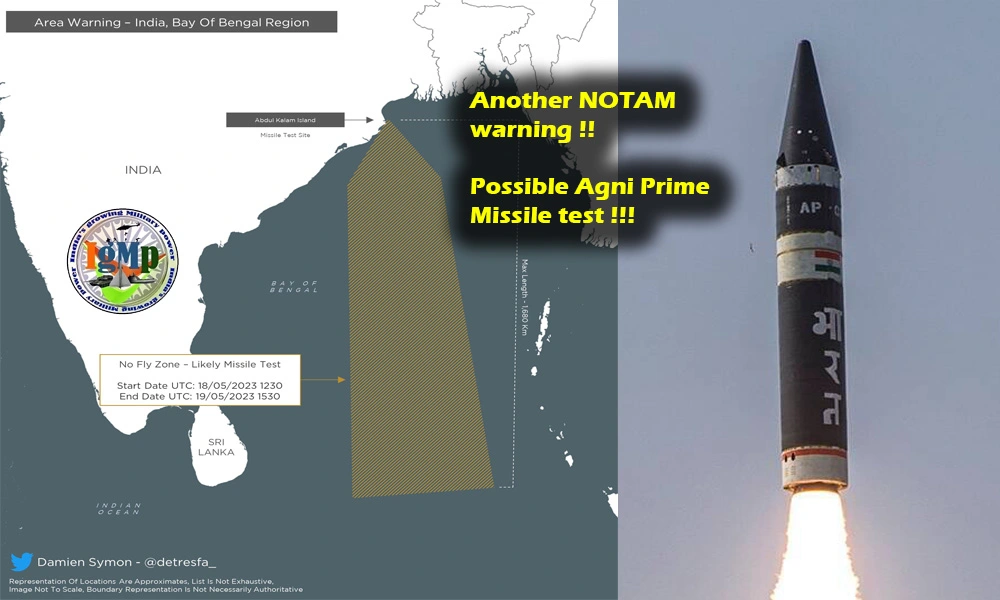Source : Indian Defence Analysis

India issues another NOTAM warning for a range of 1600km !!! DRDO to test Agni Prime Carrier Killer AshBM !!
India started working on area denial weapons after China had developed DF-21D and DF-26B nuclear capable missiles to counter US Navy which has brought Naval Base Guam within its reach. As a counterbalance, the progress of Agni-P became crucial part of India’s Indo-Pacific strategy to tackle China’s plan of having five or six aircraft carrier battle groups by 2035 to cover both Pacific Ocean and Indian Ocean.
Till now, DRDO has conducted 3 successful tests of Agni-P missile. The maiden trial of Agni Prime was conducted on 28th June 2021, followed by 2nd test on 18th December 2021 & 3rd test on 21st October 2022.
Recently, a No-fly zone has been issued by Indian Strategic Force Command & DRDO from 18 to 19 May 2023. The NOTAM has an area warning spanning at a distance of 1680 KM in Bay of Bengal. Considering the NOTAM distance, this test is going to be of Agni-P missile.
#AreaWarning #India issues a notification for a no fly zone over the Bay Of Bengal indicative of a likely missile test
Dates | 18-19 May 2023 pic.twitter.com/6OGU4wAc4X
— Damien Symon (@detresfa_) May 4, 2023
What makes Agni Prime special?
The Agni Prime is a two-stage solid propellant ballistic missile with dual redundant navigation and guidance system. It features a ring laser gyro-based inertial navigation system (INS) and a modern micro-navigation system (MINS) borrowed from Agni-V.
The missile has range between 1000-2000 km. It features all-composite structure including the casing which significantly reduces its weight & considerably improves its range.
Agni-P (Prime) looks more like a mini-variant of the bigger Agni-V and actually, it does incorporate many of the technologies that were exclusively developed for the Agni-V program which includes, first for India of integrating hermetically sealed tandem twin canister made of composite materials that allow easier storage of missiles and quicker salvo launches & also makes it difficult for the satellite to pick them up when on the move.
Since Agni-P is a canister launched missile, it can be stored for a longer period and can be transported across the country via rail or road as per operational requirements.
The other major enhancements of Agni-P over its predecessors includes fully upgraded composites, new propulsion systems, innovative guidance and control mechanisms and state-of-the-art navigation systems.
It is sleeker missile with weight 1/5th and dimension almost half of Agni-III missile which makes it stealthier than its predecessors. This provides the missile better evasion capability against anti-ballistic missile defence.
Agni Prime specifications
Agni-P is being developed to replace Agni-1 missiles which are having range between 700-1200 km and Agni 2 having range between 2000-3500km. Agni prime will also complement Agni 5 missiles.
The Agni-P can carry warhead between 1500-3000kg. A notable feature of the Agni-P (Prime) is four delta fins for terminal maneuver which can defeat ballistic missile defense system but can also be used as an Anti-Ship Ballistic Missile (ASBM) when a new variant is developed based on the Agni-P (Prime). The missile uses cold launch mechanism and can be fired in salvo mode.
Agni Prime: Carrier Killer
DRDO is also working on a 1,500-kilometer range conventionally armed ballistic missile with an anti-ship capability and is expected to be based on Agni Prime. Besides aircraft carrier, the new ballistic missile can also target land-based assets across the LAC in Xinjiang, Tibet, and Yunnan provinces. Due to its range the new missile will provide deterrence against the adversary’s carrier strike group and at the same time protect its own aircraft carrier. IgMp







